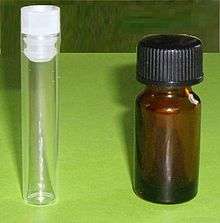Vial
For the Ancient Greek pottery, see Phiale.

A vial (also known as a phial or flacon) is a small glass or plastic vessel or bottle, often used to store medication as liquids, powders or capsules. They can also be used as scientific sample vessels; for instance, in autosampler devices in analytical chromatography. Vial-like glass containers date back to classical antiquity; modern vials are often made of plastics such as polypropylene.
Design
There are several different types of commonly used closure systems, including screw vials (closed with a screw cap or dropper/pipette), lip vials (closed with a cork or plastic stopper) and crimp vials (closed with a rubber stopper and a metal cap).[1] Plastic vials can have other closure systems, such as flip-tops or snap caps. A vial can be tubular, or have a bottle-like shape with a neck. The volume defined by the neck is known as the headspace. The bottom of a vial is usually flat, unlike test tubes, which have usually a rounded bottom. The small bottle-shaped vials typically used in laboratories are also known as bijou or McCartney's bottles. The bijou bottle tends to be smaller, often with a volume of around 10 milliliters.
Etymology
The English word "vial" is derived from the Greek phiale,[3] meaning "a broad flat container".[4] Comparable terms include the Latin phiala, Late Latin fiola and Middle English fiole and viole.
See also
- Ampoule
- Seven bowls, also referred to as "seven vials", a series of plagues mentioned in the Biblical Book of Revelation
- Vacutainer
References
| Look up vial in Wiktionary, the free dictionary. |
| Wikimedia Commons has media related to Vials. |
- ↑ "Cappers". Pharmaceutical Online. Retrieved 8 March 2013.
- ↑ "Fiole miniature" (in French). Louvre Museum. Retrieved 14 July 2013.
- ↑ "Vial at Merriam-Webster's Online Dictionary". Merriam-Webster. Retrieved 15 September 2012.
- ↑ "Phiale". About.com. Retrieved 4 June 2012.
Bibliography
- Hans-Jürgen Bässler and Frank Lehmann (2013). Containment Technology: Progress in the Pharmaceutical and Food Processing Industry. Springer (Berlin). ISBN 978-3642392917.
